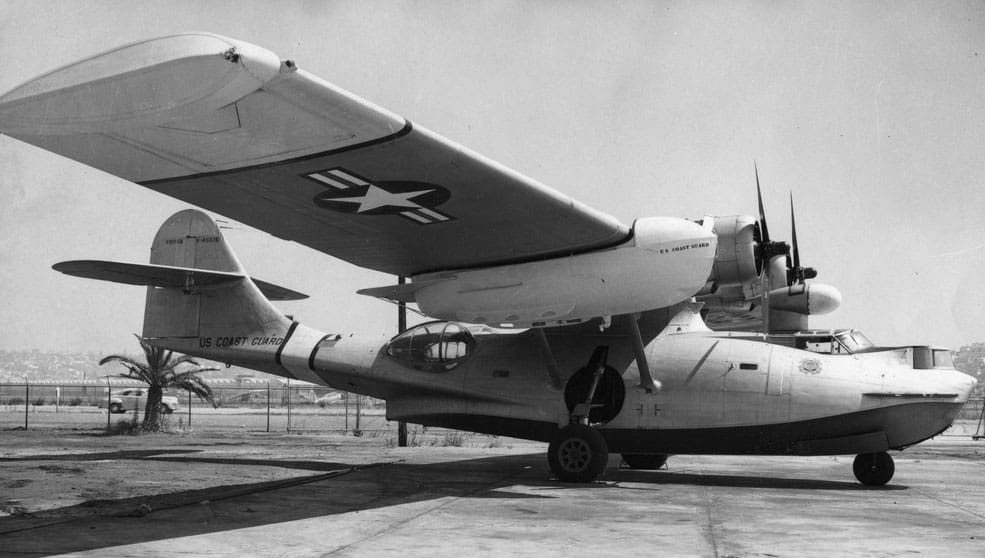
The Consolidated PBY Catalina was created in response to the U.S. Navy’s request to replace the Consolidated P2Y and the Martin P3M. The XP3Y, designed by Isaac Laddon, distinguished itself clearly from its precursors by its monoplane configuration. First flown in 1935, it was an all-metal flying boat with internal wing bracing which greatly reduced drag. The wing tip floats retracted upward into the wing tip adding to the aerodynamics of the wing. Performance was modest but it was a sturdy, reliable aircraft, ideally suited for long patrols over the oceans.
The US Navy had given the prototype the designation P3Y, but then changed it to PBY because of the Catalina’s ability to carry four 1000 pound bombs under the wing. PB meant “patrol bomber”, and Y was the manufacturer letter assigned to Consolidated. Consolidated received an initial order for 60 PBY-1s, the first production model, in 1935. The first aircraft of this series entered service in 1937. They were followed by 40 PBY-2s, 66 PBY-3s, and 33 PBY-4s; the latter model introduced the large dorsal blisters that became so characteristic for the Catalina. Starting in September of 1940 there were 684 PBY-5s built. A retractable tricycle landing gear was added and the amphibian PBY-5A became operational in October 1941. The name Catalina was given to the aircraft by the British, but later also adopted by the U.S. Navy. It was called a Canso by the RCAF.
Two Pratt & Whitney R-1830 radial engines were installed in the wing leading edge just aft of the cockpit. To keep the propellers away from the water, the wing was put on top of a sturdy pylon, and braced with two struts on each side. The fuselage itself had a two-step flotation bottom, and a rounded upper side. The fuselage was wider than it was high, an unusual feature for a flying boat, and inside there was only one deck. In the nose, there was a position for a gunner / bombardier. Behind him was the cockpit for the two pilots, and immediately aft of the cockpit there was a cabin for the navigator and the radio operator. Behind them was the flight engineer, whose workplace extended into the wing pylon. Aft of the wing there was a cabin with bunks; finally, there were two waist gun positions covered, in most versions, with large blisters. The PBY was one of the first US aircraft to carry radar. At first this was a metric wave radar with arrays of dipole antennas on the wings, and later a centimetric radar in a fairing on top of the cockpit. A Leigh light was installed under the wing.
The Naval Aircraft Factory built 156 Catalinas. These were designated PBN-1 and named Nomad. They had a new, sturdier wing, larger fuel tanks, a longer hull, and a taller tail surface. These changes were also incorporated in the PBY-6A
The first PBY obtained by the Coast Guard, V189, was purchased from the Navy in the spring of 1941. It was specially outfitted at Air Station San Francisco with a nine-lens-camera for mapping coastal regions around the country. While the arrangement worked well in the lower 48, after two mapping trips to Alaska the camera was transferred to a newer PBY-5A (PBY BuNo 08055), an amphibian, making it more versatile in the extreme environment of Alaska. The detachment operated out of NAS Kodiak.
Because of the Navy’s great need for PBY patrol aircraft in the North Atlantic and the Pacific it would be early 1943 before the Coast Guard acquired them in significant numbers.
In 1943 Construction of the Pacific LORAN chains began. Coast Guard PBY aircraft, V189, reported for duty, having been assigned by Headquarters to transport personnel, mail, supplies, and materials, to the various sites to expedite the construction. Flight surveys of the sites for the Loran stations were made. These inspections provided a good grasp of the problems involved in the landing of materials and the construction of the stations. Construction of the Loran chains began in Alaska and the construction of additional chains followed the battles across the Pacific to Japan. V-189 was permanently assigned to this Top Secret project.
On 5 October 1943 an all Coast Guard Patrol Squadron, VP-6 CG, home based at Narsarssuak, Greenland, code name Bluie West 1, became operational. Thirty officers and 145 enlisted men were assigned to the squadron. In the hostile environment of the North Atlantic VP-6 provided anti-submarine patrol, air support for convoys, search and rescue, intelligence survey flights, as well as mail and medical supply delivery.
In December of 1943 the Navy established its’ first Air Sea Rescue Squadron at Air Station San Diego. An all Coast Guard unit, it led to the Coast Guards heavy involvement in Air-Sea Rescue. Starting in 1944 the Coast Guard had the Search and Rescue responsibility for the Continental Sea Frontiers. By the end of 1944 there were 114 PBY-5A/6As in Coast Guard service.
| Manufacturer | Consolidated Vultee | Designation | PBY; PBY-5A; PBY-6A |
| Aircraft Type | Patrol flying-boat | Wing Span | 104’ |
| Cruise Speed | 125 mph | Height | 18’ 11” |
| Stall Speed | 69 mph | Length | 63’ 10” |
| Fuel Capacity | 1,750 gallons | Empty Weight | 15,384 lbs |
| Range | 4000 miles @ 6000 ft. | Gross Weight | 24,332 lbs |
| Service Ceiling | 23,400 ft. | Engines | Two R-1830 Radial–1200hp |
| Crew | 7 | Propeller | Curtiss-controlled pitch |
| Armament | Two .50 caliber machine guns; up to three 30 caliber machine guns; 4000 pounds of bombs, torpedoes or depth charges. | ||
